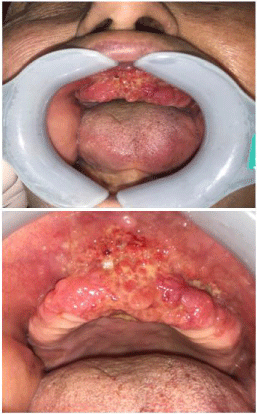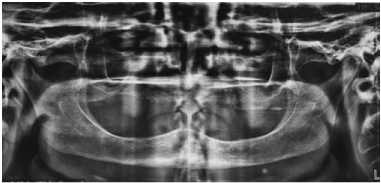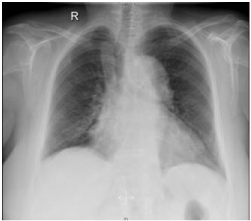Case Report
Primary Tuberculosis of the Oral Cavity: A Case Report
Ababtain R1, Alohali A1 and Binahmed A2*
1Department of Head and Neck Surgery, King Saud Bin Abdulaziz University, Riyadh, Saudi Arabia
2Department of Oral & Maxillofacial Surgery and Head & Neck Surgery, King Abdulaziz Medical city, Riyadh, Saudi Arabia
*Corresponding author: Abdulaziz Binahmed, Department of Oral & Maxillofacial Surgery and Head & Neck Surgery, King Abdulaziz Medical city, 22490 Riyadh, 11426, Saudi Arabia
Published: 30 Mar, 2017
Cite this article as: Ababtain R, Alohali A, Binahmed A.
Primary Tuberculosis of the Oral Cavity:
A Case Report. Clin Surg. 2017; 2:
1377.
Abstract
Tuberculosis is a chronic granulomatous disease that usually affects the lungs but could also occur
in other organs such as the oral cavity. Mycobacterium Tuberculosis is the main causative organism
and is typically transmitted through the respiratory tract by inhaling droplets contaminated by
these organisms. Oral tuberculosis is a challenging lesion to diagnose due to its various clinical
presentations. Hereby, we present an interesting case of gingival overgrowth in the anterior maxilla
that mimics a malignant lesion. Unexpectedly, histopathological examination confirmed the
diagnosis of tuberculosis. Further investigations were done to rule out pulmonary tuberculosis.
Keywords: Tuberculosis; Oral tuberculosis; Gingival enlargement
Abstract
Tuberculosis (TB) is a chronic infectious disease that is caused by the Mycobacterium species,
most commonly M.Tuberculosis. It commonly affects the lungs but could also present as extrapulmonary
or secondary TB by residing in other organs such as skin, bone, gastrointestinal tract,
genitourinary system and oral cavity [1]. Extra-pulmonary TB accounts for approximately 10-15 %
of TB cases while only 0.2 - 1.5 % of these cases occurs in the oral cavity as secondary to pulmonary
TB [2].
Pulmonary TB is the common presentation of TB with the classical symptom of a productive
cough. TB can spreads to the oral cavity through either infected sputum or through a hematogenous
route [3].
Oral TB is uncommon and has various clinical pictures, which makes it easier to miss in
diagnosis. It commonly presents as ulcers, granules or indurated soft tissue lesions. It can be
commonly found on the tongue but can also be seen in other sites such as the lip, cheeks, soft palate,
and uvula, gingival and alveolar mucosa [3].
This paper presents a case of oral tuberculosis affecting the maxilla in a Saudi female patient with
no symptoms of pulmonary TB.
Case Presentation
This is a case report of a 72 year-old Saudi female, known to have diabetes mellitus, hypertension
and hypothyroidism with a positive history of cerebrovascular accident 10 years back. The patient
presented to the Oral and Maxillofacial outpatient clinic in King Abdulaziz Medical City (KAMC)
in Riyadh, Saudi Arabia complaining from a painless swelling in the anterior maxilla, which
was noticed 1 year ago. The swelling was gradually increasing in size with a negative history of
cough, fever or weight loss. Extra-oral examination revealed non-tender and non-palpable lymph
nodes. Intraoral examination showed an ill-defined granular papillary growth in the anterior
maxilla extending from area of right canine to left first premolar. The lesion was firm, non-tender,
erythematous, and shiny in appearance with areas of ulceration. However, there was no bleeding
or pus discharge. Based on the suspicious clinical presentation an initial diagnosis of squamous cell
carcinoma was made (Figure 1).
Orthopantomography (OPG) was taken for the patient and showed no osseous involvement
(Figure 2). Blood work up including; complete blood count, basic screening and coagulation profile
were within normal limits. Incisional biopsy was done under local anesthesia, fixed in formalin and
sent for histopathological & PCR examination. Neck & facial bone CT and chest x-ray were also the histopathological findings in the excised specimen included
granulamtous inflammation highly suggestive of tuberculosis. TB
PCR analysis was positive for M.tuberculosis complex.
Radiographic findings of the CT showed few bilateral pathological
lymph nodes at the right level I B, left level II A&B, and smaller ones
seen at level III & IV bilaterally. It also displays patent neck vessels
and clear upper lungs.
Cardiomegaly with torturous aorta was seen in the chest X-ray
with clear lung fields, no pleural effusions or pneumothorax, and no
significant osseous abnormalities seen (Figure 3).
Patient was referred to the infectious disease department in
KAMC for management with regular follow up appointments with
OMFS clinic. Anti-tubercular treatment was initiated by her physician
with phase I including isoniazid, ethambutol and pyrazinamide for
3 months. Followed by a second phase, which includes ionized and
moxifloxicin for 6 months. Patient was seen with infectious disease
after 3 weeks of treatment she was doing well and tolerating the
medications. There was regression in the size of the lesion.
Figure 1
Figure 2
Figure 3
Discussion
Mycobacterium Tuberculosis is an anaerobic, non-motile, noncapsulated,
non-spore forming rod shaped organism that is the
main bacteria responsible for tuberculosis [4]. Epidemiology of TB is affected by ethnicity, age, and socioeconomic status [5]. The global
burden of TB can be appreciated in a recent report by the WHO were
cases of TB reached 8.6 million cases worldwide and death-related TB
cases were around 1.3 million [6]. In the Kingdom of Saudi Arabia
(KSA) the latest prevalence of TB ranged from 8.5 % in central region
to as high as 23.1 % in Hail [7]. According to a recent study done
by Alorainy “et al.” [8]. Assessing the incidence of tuberculosis in
Saudi Arabia, "There were a total of 64,345 TB cases reported to the
Ministry of Health during 1991-2010. Of these, there were 46,827
(73%) pulmonary TB cases and 17,518 (27%) extra-pulmonary TB.
There were 33,468 (52%) Saudi patients and 30,837 (48%) non-
Saudis. The majority (62%) were males. Over 70% of the cases were
reported from the Central and Makkah regions”. The pathogenesis of
oral tuberculosis is not clearly understood; however different routes
of inoculation were suggested. It can occur through a hematogenous
or lymphatic route in secondary TB or through direct inoculation
as in primary TB. The incidence of oral TB is rare and has been
attributed to the mucous membrane that acts as a barrier for the direct
penetration of the organisms. Furthermore, the cleansing action of
the saliva, local PH and the antibodies increase the resistance of the
oral cavity. On the other hand, trauma, inflammatory conditions, and
tooth extractions cause a break in the mucosa providing an access for
the organisms [4-6,9-11].
Children and adolescents appear to be the most common group
affected by primary TB [10,11] with a male predominance [9]. While secondary TB appears to affect older age groups [4]. The tongue is
the most common site for oral TB but can also be found in other sites
including the palate, lip and buccal mucosa. It is not uncommon to
see oral TB lesions in the alveolar mucosa, tonsils, salivary gland and
uvula [4,6,10-12].
General systematic symptoms include a productive cough, weight
loss, anorexia, night sweats, fever, lymphadenopathy and hemoptysis.
These general symptoms are rarely associated with primary oral
TB. Nonetheless, TB should be rule out if the patient presents with
these symptoms [10]. In secondary TB, oral lesions secondary to the
pulmonary changes may appear prior to systemic symptoms [12].
The presentation of oral TB is not specific but most commonly
occurs as an ulcer. This makes differential diagnosis difficult and
should include ulcerative diseases such as syphilis, malignancies,
traumatic or aphthous ulcers, sarcoidosis, actinomycosis, and erosive
lichen planus [11,12]. Ulcers caused by TB are usually painful,
persistent, not responding to topical treatment, with indurations and
irregular borders [4,6]. Variations in presentation can occur including nodules, granulomas, verrucous proliferation, and papillary forms [10].
Diagnosis of oral TB is very difficult to be done based on
clinical presentation only. It is essential to have histopathological
analysis to confirm the diagnosis. The histological picture of TB is
generally the presence of a granulomatous inflammatory infiltrate
with Langerhans giant cells and lymphocytes. It is also common to
observe foci of caseating necrosis in the tissues [6,12]. Culture test
can show the presence of acid-fast bacilli; however it takes 4-6 weeks
and lacks sensitivity [14]. Due to the relative scarcity of bacilli within
the oral biopsy, it can only be detected in 27-60% of the cases [9,11].
This lead to the emergence of polymerase chain reaction (PCR)
analysis in detecting and amplifying the DNA even if few genomes
are present. PCR is highly specific (98%) and sensitive (94%) in
detecting M.Tuberculosis [19,13]. In our case, the histopathological
examination showed the classical picture of TB and was confirmed
by PCR analysis.
Tuberculosis is treated with systematic anti-tubercular therapy
in two phases regardless of the primary site. The first phase requires
2 months of therapy with 3 or 4 antibiotics including isoniazids,
rifampicin, pyrazinamide and ethambutol. Followed by second
phase of 4 months with only two drugs most commonly isoniazids
and rifampicin [6,10,12]. In case of drug resistance, a second-line
of drug therapy is recommended which includes amino glycosides,
polypeptides, flouroquinolones, cycloserine, and terizidone.
Conclusion
Oral tuberculosis lesions are relatively rare, difficult to diagnose and could be a possible infectious hazard to the healthcare personnel. Thorough history and clinical examination should be done to rule out TB and explore other primary sites.
References
- Prem PG, Sanjay F, Dipti A, Pradeep S. Primary tuberculosis glossitis in an immune competent patient. Hong Kong Med J. 2007;13(4):330-31.
- Iype EM, Ramdas K, Pandey M, Jayasree K, Thomas G, Sebastian P, et al. tuberculosis of the tongue: report of three cases. Br J Oral Maxillofac Surg. 2001;39(5):402-3.
- Hashimoto Y, Tanioka H. Primary tuberculosis of the tongue: report of a case. J Oral Maxillofac Surg. 1989;47(7):744-6.
- Ram H, Kumar S, Mehrotra S, Mohommad S. Tubercular ulcer: mimicking squamous cell carcinoma of buccal mucosa. J Maxillofac Oral Surg. 2012;11(1):105-8.
- Tanwar R, Iyengar AR, Nagesh KS, Jhamb P. Primary tuberculosis: an unusual finding in the oral cavity. Oral Health Dent Manag. 2012;11(1):23-8.
- Jain P, Jain I. Oral Manifestations of Tuberculosis: Step towards Early Diagnosis. J Clin Diagn Res. 2014;8(12):ZE18-21.
- Watban A, Salamah A, Faki M. Prevalence of suspected tuberculosis in the Kingdom of Saudi Arabia according to conventional and molecular methods. J Family Community Med. 2014;21(3):182-5.
- Al-Orainey I, Alhedaithy MA, Alanazi AR, Barry MA, Almajid FM. Tuberculosis incidence trends in Saudi Arabia over 20 years: 1991-2010. Ann Thorac Med. 2013;8(3):148-52.
- Karthikeyan B, Pradeep A, Sharma CG. Primary Tuberculous gingival enlargement: A rare entity. J Can Dent Assoc. 2006;72(7):645-8.
- Verma S, Mohan RP, Singh U, Agarwal N. Primary oral tuberculosis. BMJ Case Rep. 2013;2013.
- Kumar B. Tuberculosis of the oral cavity affecting alveolus: a case report. Case Rep Dent. 2011;2011:945159.
- Krawiecka E, Szponar E. Tuberculosis of the oral cavity: an uncommon but still a live issue. Postepy Dermatol Alergol. 2015;32(4):302-6.
- Bhat M, Behal R, Jan S, Khan F. Primary tuberculous gingival enlargement: A rare clinical entity: Case report and brief review of the literature. J Indian Soc Periodontol. 2014;18(5):632-6.
- Mignogna MD, Muzio LL, Favia G, Ruoppo E, Sammartino G, Zarrelli C, et al. Oral tuberculosis: a clinical evaluation of 42 cases. Oral Dis. 2000;6(1):25-30.



